#Polish folk witch
Text
Dual faith folk witches
Polish Folk Witch (on instagram and Patreon) has an excellent article on dual faith practice and syncretism among folk witches: Dual Faith: the elephant in the room of the witchcraft community.
The topic of dual faith keeps returning on a regular basis in the broader witchcraft community online, especially on the intersection of folk magic, paganism and christian occultism.
Folk witches often…
View On WordPress
#diversity#dual faith#dual-faith practice#dvoeverie#folk Catholicism#folk witches#noteworthy posts#occult#Pagan#Polish folk witch#practice#religious identity#spirituality#syncretism#tradition#Wicca#witchcraft
52 notes
·
View notes
Text
Folk witches and dual faith
Polish Folk Witch (on instagram and Patreon) has an excellent article on dual faith practice and syncretism among folk witches: Dual Faith: the elephant in the room of the witchcraft community.
The topic of dual faith keeps returning on a regular basis in the broader witchcraft community online, especially on the intersection of folk magic, paganism and christian occultism.
Folk witches often…
View On WordPress
#Christianity#dual faith#dual faith practice#dvoeverie#folk witches#other people’s journeys#Paganism#Polish folk witch#spiritual wobbles#syncretism
0 notes
Text

#witch#slavic folk#baba yaga#spooky#watercolor daily#watercolor#watercolor art#magic#mystic#femine#forest#aleksandra czudżak#illustration#witchcraft#mushrooms#czudżak#artwork#slavic#polish folklore#contemporary illustration
419 notes
·
View notes
Text
Tales of regional devils, elements of Christianity, remnants of beliefs in old Slavonic spirits and demons, combined with variations in folklore to provide a rich tapestry of demonology. Since in the majority of Polish witchcraft confessions there were no references to familiars, it can be suggested that the personification of the devil was an analogous concept.
However, the familiar nature of devils could equally be perceived as a continuation of the tradition of the domovoi (house spirits), who were an important part of ancient Slavonic mythology. They were mischievous, rather than harmful spirits who looked afer the home and were placated with offerings of food. Christianity, according to Pełka and Baranowski, demonized these harmless creatures. The lingering spirit of the Christian could conveniently be viewed as a Slavonic water or forest spirit, and many of them were identified with liminal Christian situations, such as death without the appropriate rites, for example suicides or the death of unbaptized infants. Thus from a brief examination of the trial records and printed sources, one can see that the portrait of the devil serves a variety of purposes and beliefs and appears to be distinctly different within elite and popular cultures.
- Jewish, Noble, German, or Peasant? The Devil in Early Modern Poland by Wanda Wyporska. [Demons, Spirits, Witches Vol. 2 :Christian Demonology And Popular Mythology - Gábor Klaniczay, Éva Pócs (Eds.)]
148 notes
·
View notes
Photo
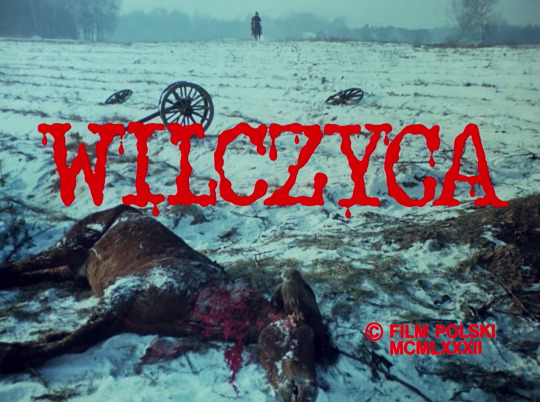

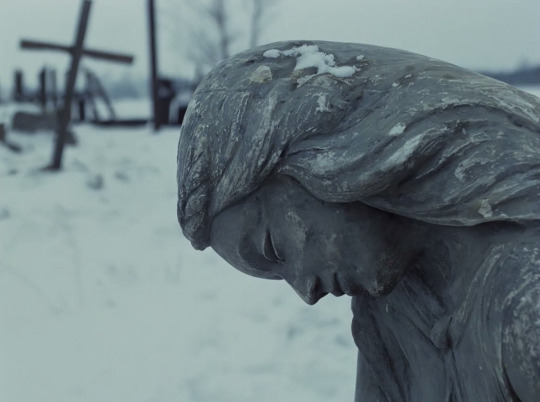


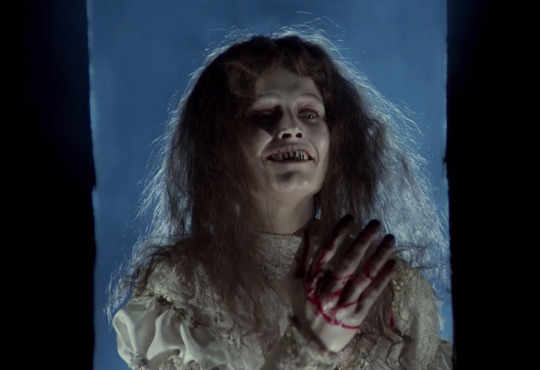




Wilczyca, 1983, dir. Marek Piestrak
#Horror Movies#horror aesthetic#Aesthetic#polish horror#80s horror#folk horror#witches#were-creatures#wilczyca
256 notes
·
View notes
Text
As I feared, trying to connect to my Polish roots through magical traditions is quite difficult, because a lot of that stuff was lost or altered after Catholicism permeated the region. I've been able to find some folklore, and I've found a few leads on books of Slavic folk magic that at least touch on Poland, but most of my searching thus far has just turned up other witches of Polish descent trying to connect with their heritage and coming up with the same meager handful of texts and sources
#i did find a practicing polish folk witch in the same general region our family is from#i will likely have to actually use instagram for this to be a useful resource though...
0 notes
Note
Hello! I was wondering... kinda cringy but can I request comparing hand sizes with Soldier boy headcanons
Hey love!! ❤️
Aw, it's not cringey. That's actually really cute! Let me see what I can do for you...
Pairing: Soldier Boy x Female Reader
Word Count: 500
Tags/Warnings: 18+ only on this one, folks! For some smutty musings on those talented fingers.
Headcanon: The way you love Ben's hands.

You love playing with his hair, slipping your fingers through the soft strands.
But you also love his hands.
Despite the pampered lifestyle he led growing up, Ben is a very tactile person. He likes working with his hands.
You like to catch him when he's cleaning his weapons. He takes them apart and puts them back together expertly. His smooth hands and long fingers glide as they polish metal with a small rag.
You like to watch him try and fail to cook, ultimately burning the eggs. You like the way his hands move quick yet awkward with the wooden spoon scraping across the pan.
(He burns the bacon too. "It's better that way, extra fucking crispy," he grumbles, when you tease him.)
You like the strength in his hands, tempered just for you.
When his fingers brush across your cheek. When they graze your arm absently while something plays on TV. When he comes up behind you and rests a heavy hand at the small of your back. Or when they grip your hips and thighs and ass hard enough to bruise.
When those talented fingers tease you, slipping between your legs and finding the source of your pleasure with ease.
Long fingers slowly dipping inside your wet heat, exploring your inner walls with the practiced patience of a man fully familiar with every part of you.
They know where and how and when to twist and curl, making you utter broken gasps of his name and shudder from deep within.
And Ben gets something he loves: the sound of your voice as you come hard on his fingers, and make it known in his ear...
But sometimes, it's just as simple as laying with him in bed, afterwards, holding one of his hands in yours.
Your fingers trace over each and every one of his, noting the differences of his larger hand in your smaller one. You compare them in your mind: both different versions of smooth, his masculine to your slender. His blunt nails to your longer ones.
One night, you even line up your hand against his, like Tarzan and Jane.
His brows furrow. "The hell're you doing?"
A smile tugs at your lips. "Nothing. You've just got huge hands."
He snorts. "I have a man's hands."
You roll your eyes. Right. But your smile deepens when you bring the back of his hand to your lips. You turn it over and press a sweet kiss into his palm, closing your eyes.
Ben tolerates it.
Or so he'd have you believe.
Really, he just watches you as a tendril of warmth plumes in his chest. His lips hint at a smile.
There are wordless moments when he knows you love him.
He'll probably never tell you out right, but times like these are some of the ones he likes most with you.
They stay in his memory long afterwards. And when the darker ones threaten to cloud his day, he pulls these moments out like old photographs, imprinted on his mind.

AN: Hehe, hope you guys like this one! ❤️
Just so you know, there's a longer SB imagine coming soon (either this coming week or next), and it is ✨Angsty.✨ 😅
I'll probably release an interesting one next. Though the request was a bit niche, I really got into it! So I'm hoping you all will enjoy. It includes reactions from Dean Winchester, Beau Arlen, and Soldier Boy (Ben)...

Soldier Boy Masterlist
Main Masterlist
SB Tag List:
@melancholictearz @katherineann83 @sleepyqueerenergy @wayward-lost-and-never-found @thewritersaddictions @samanddeaninatrenchcoat @deanwanddamons @antisocialcorrupt @adoringanakin @theonlymaninthesky @teehxk @midnightmadwoman
@iprobablyshipit91 @agalliasi @venicesem @deans-spinster-witch @chriszgirl92 @lyarr24 @ladysparkles78 @solariklees @xsophianicolex @deansbbyx @mimaria420 @candy-coated-misery0731 @curlycarley @sarahgracej @bagpussjocken @ultrahviolentart @skyesthebomb @this-is-me19 @kazsrm67 @letheatheodore
@agothwithheavysetmakeup @jacklesbrainworms @foxyjwls007 @wincastifer @emily-winchester @tearsfortheyouth @solo-pitstop-vibes @dope-trope-105 @liuope @beautyvaliant @xxlaynaxx @chernayawidow @beskarfilms @tmb510 @iamsapphine @vanillawhiskeyflavoredkisses @roseblue373 @lacilou

#ask me stuff#soldier boy#the way you love his hands#comparing hand sizes#soldier boy headcanon#smuttish#fluff#Soldier Boy imagine#soft!Ben#the boys#soldier boy/ben#soldier boy x reader#soldier boy x female reader#soldier boy x you#zepskies answers
493 notes
·
View notes
Text
Protective household demons in Polish folklore
Belief in protective household demons was in all likeliness widespread among Slavic peoples from time immemorial. We do not know how those demonic creatures were imagined and what forms of cult were associated with them in the distant past, since the first sources on this subject we find in confessional literature of the late Middle Ages. In the XV-th century sermon fragment mentioned in previous chapters we find words of disapproval towards folk practice of „feeding” the protective spirits of the house called ubożęta (singular: ubożę).
”There are those who do not wash the dishes after dinner on Great Thursday and holy day, so as to feed the souls that they call vbosshe (ubożę) and others, believing stupidly that spirits need corporal things, when it is written that the Spirit does not have flesh or bones. Some purposefully leave the remains of dinner on their plates, to thus feed the souls or a certain demon that they call vbosshe, but this is completely ridiculous, because they often think, foolish and naive, that what they have left is food for the aforementioned vbesshe, since they care for it to attract good luck, but very often it is a dog that comes without them realizing and devours the remains.”
- Anonymous sermon, XVth century Poland, translation from „Sources of Slavic Pre-Christian Religion”, red. Álvarez-Pedrosa
The same problem was also touched on in two other works, the XVI-th century „Postępek prawa czartowskiego przeciw narodowi ludzkiemu” (roughly translates to „The Progress of Devilish Deeds Against the Human Nation”) and XVII-th century „Czarownica powołana” (roughly „The Witch Appointed”), whose authors were critical of the common practice of the housewives leaving a special, separate evening meal to the protective spirits of the household. P. Gilowski in his XVI-th century „Wykład katechizmu Kościoła krześcijańskiego z pism świętych” (roughly „Explaining the cathechism of Christian Church from holy scripture”) counted protective household spirits among satanic apparitions and wrote „… there are various sorts of devils, earthly skryatkowie (the modern word would be „skrzaty”), domestic ubożęta…”. According to B. Baranowski on the territory of central Poland in XVII-th and XVIII-th century „the belief in all sorts of protective deities remained exceptionally deep. Quite often they were some sorts of household spirits. (…) One was supposed to leave them a little bit of food in the corner of the hut or in the hall and they would then ensure good luck and wealth of the house. Other creatures of this sort were said to live in barns. For this reason one of the boards in the roof of the barn would be left loose, without nails or a small hole would be made in it, and thus it was ensured that the spirit can enter the barn at will.”
The aforementioned ubożeta, skrzaty and other related protective house spirits, similarly to atmospheric and natural demonology, were included in the family of devilish beings during the Counter-Reformation. On this basis, completely new images of domestic demons were formed, such as the diabeł-latawiec (a character combining elements of an atmospheric demon, a protective household spirit and the devil) or a diabeł-chowaniec (devil-familiar). Both of these beings were credited with activities aimed at securing abundance and prosperity on farms. As a consequence, this led to the formation in the minds of the rural people of the dual nature of devilish beings, that could be either dangerous and harmful or good and caring. The latter group included, among others, guardian house demons.
Concurrently, in the second half of XVIII-th century Catholic clergy started their own varied efforts towards broader dissemination and popularization (especially in rural areas and small towns) of the cult of angelic beings in particular guardian angels. To the latter they would assign very specific protective functions which were supposed to result in complete erasure of traditional beliefs in household spirits that were still present in the popular consciousness. The Church doctrine of that time stated that every person has a God-assigned guardian angel whose task is to guard their charge from all kinds of dangers and temptations. An interesting aspect of that protection was the constant war guardian angels and devils would wage over the salvation of human soul. This concept also found it’s reflection in the developing folklore, for example in an eschatalogical piece „Przemowa Diabła i Anioła przy łożu Umierającego” (translates to: The Speech of a Devil and an Angel by the bed of a Dying Man).
- Polska demonologia ludowa by Leonard Pełka, amateur translation by Zarya-Zaryanitsa
190 notes
·
View notes
Text

I Come With Knives
Azris, 13k words, rated E.
A party on the continent, hosted by one of Koschei’s lackeys, goes awry. Nearly magicless, Azriel and Eris must survive on the continent together or die trying. Inspired by The Nutcracker, with a helping of Polish folk tales.
I’m so pleased to finally post this for my sweet friend, @krem-does-stuff!! I was so excited to get you for this year’s @acotargiftexchange, and I hope you enjoy it! Your theories about what my TikToks could mean had me rolling with laughter, because you were rather wrong, haha. I have so many more rat/Nutcracker-related TikToks to send you, and hopefully they’ll make (slightly) more sense once you’ve read this. I tried to incorporate all the desserts you gave me (raspberries are very important in this), and I tried to write Eris in a way that was new to me but still believable and delightfully mean.
Special thanks to @witch-and-her-witcher, @queercontrarian, and @yanny-77 for their beta skills; to Cee and Emma again for saying “send the TikTok” and holding my hand through the usual self-doubt; @pippsmcgee for shaking this fic until nearly all the present continuous fell out of it; @velidewrites for helping me translate a few things into Polish; @damedechance for helping me find something dirty to say; and, ofc, Dylan O’Brien. You know why.
Read on ao3.
Azriel stares out at the crowd, at the finery draped over every inch of this infernal castle, and he can almost pretend nothing is wrong. His leathers – he had refused to wear something more formal – creak as he shifts his weight, though it’s eaten up by the merry shouting of the crowd.
This invitation had come, bristling with glitter and tied with a ribbon, from one of the lesser noble houses of a small duchy close to the border with Rask. The duke and duchess were newly appointed and quite young, only in their eighties. Let bygones between continent and island be bygones, the invitation had crowed.
It stunk of a trap, and Azriel had come because there was no one else who could.
Rhys had Feyre, Nyx, and a death bargain no one could undo. They couldn’t spare Cassian, never mind that Nesta wasn’t ever letting Cassian out of her sight again. Mor and Lucien never figured into the equation, Lucien because he wasn’t stupid, and Mor because she wasn’t authorized by the Queen of Vallahan to go anywhere else on the continent.
It’s Amarantha all over again. None of the original players are here, of course; none of them would be so stupid. But apparently not smart enough to stay out entirely.
89 notes
·
View notes
Photo
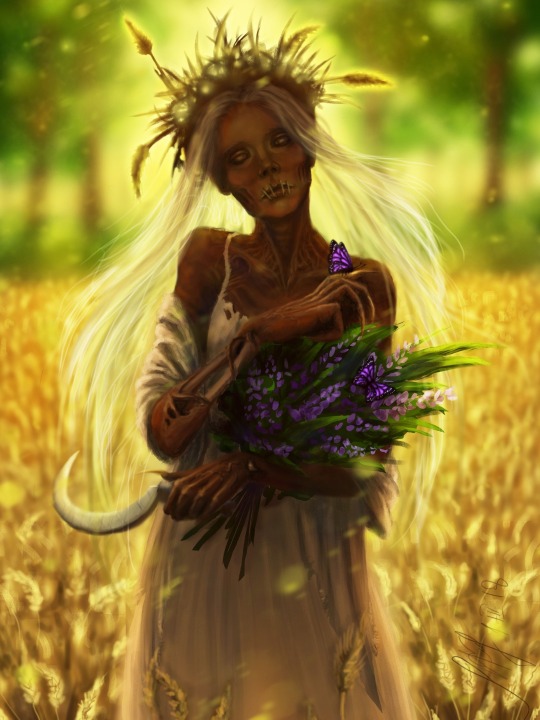


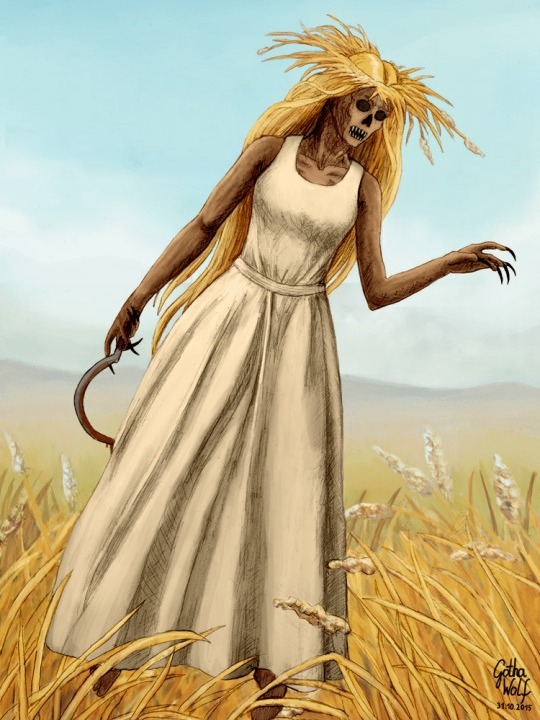
POLUDNITSA (LADY MIDDAY)
🌾 Poludnitsa (from: Polden or Poluden, 'half-day' or 'midday') is a mythical character common to the various Slavic countries of Eastern Europe. She is referred to as Południca in Polish, Полудница (Poludnitsa) in Serbian, Bulgarian and Russian, Polednice in Czech, Poludnica in Slovak, Připołdnica in Upper Sorbian, and Полознича (Poloznicha) in Komi, Chirtel Ma in Yiddish.
🌾 She is a noon demon in Slavic mythology. She can be referred to in English as "Lady Midday", "Noonwraith" or "Noon Witch". She was usually pictured as a young woman dressed in white that roamed field bounds. She assailed folk working at noon causing heatstrokes and aches in the neck, sometimes she even caused madness.
🌾 In some accounts, she symbolizes the midday star, thereby being the sister of Zarya-Zarenitsa (the morning star; also called Utrenica), Vechorka (the evening star; also called Wieczornica/Vechernitsa) and Kupalnitsa (the night star; also called Nocnica/Nochnitsa); Poludnitsa is the second youngest among the sisters, with Zarya-Zarenitsa being the youngest and Kupalnitsa being the oldest.
🌾 Poludnitsa, who makes herself evident in the middle of hot summer days, takes the form of whirling dust clouds and carries a scythe, sickle or shears; most likely the shears would be of an older style, not akin to modern scissors. She will stop people in the field to ask them difficult questions or engage them in conversation. If anyone fails to answer a question or tries to change the subject, she will cut off their head or strike them with illness. She may appear as an old hag, a beautiful woman, or a 12-year-old girl, and she was useful in scaring children away from valuable crops. She is only seen on the hottest part of the day and is a personification of a sun-stroke.
🌾 Poludnitsa, according to beliefs, loves to dance. If she sees a girl lying down to rest in the field, she will wake her up and begin to persuade her to dance. If the girl agrees, she will be forced to dance until the “evening dawn“. Poludnitsa cannot be beaten in dancing; however, if such a girl is found, the noon spirit will present her with a rich dowry.
#Poludnitsa#Lady Midday#slavic culture#slavic#slavs#slavic folklore#pagan#poland#russia#serbia#bulgaria#czechia#czech republic#slovakia#slavic mythology#posted by me#🔮
621 notes
·
View notes
Text
Hades 2, and while I'll forever be on my 'you actually can do a retelling of the Hades/Persephone myth without treating Demeter like a helicopter parent AND giving her her justified rage, yes I'm looking at you Lore Olympus' bullshit.
Spoilers I guess as I got to the part of the game that isn't developed yet. I'll put them under Read More
Pro's:
This is a very well polished Early Access. I've yet to encounter a bug, and I can live with the fact that some image tiles don't exist yet, and some are just plain drawings.
All the minor deities/Mythological folk are done well. I'm never forgiving them for the lack of Ariadne (include her you cowards, you can include a Dead God, give me my girl). I do in fact keep wanting to punt Narcissus and I cannot wait for his image tile. He better be the twinkiest twink to ever exist. Echo, my poor girl, I just want to hug her.
Heracles, my beloved, they did your very justified rage right. You keep trying to tell Mel, And honestly I'm with you my guy. It is bullshit she gets all these Boons and you have to literally fight for it. Every time I get a Hera Boon I just want you to shake Mel and be like 'RUN GIRL'
Moros, don't make me love you, I'm trying here.
I'm loving how we're getting to see the effects of their dark side too.
Chronus. Death to Chronus but lord he terrifying. Eris is exactly the kind of maniacal shit stirrer she ought to be and I'm tossing your apple away the first chance I get. Icarus is obviously Bae (or was at one point) and oh honey.
Hecate and her Witches (Medea! Circe!) are exactly the kind of terrifying powerhouses they ought to be and while I won't forgive them for the six pack (WHY) she's just so Good. Caring, strict, and truly a believer in Mel and her task. Solid Mom A+
Cons:
Obviously it's not finished yet but for 30$ it's solid. I don't appreciate having to pay to be a Game Tester (pay people for that), but for a game I've looked forward to, for an independent studio? Sure, yeah I did it for Nightingale and that's literally just sticks and hopes. This is far more polished.
The story and its infinite replayability seems obvious in that literal Time will just rewind to where you don't defeat him, but I really hope you can pull the family out of their prison.
You have to fight the Goodest Boy. You maniacs, he's just sad, let me just pet him :(
Odysseus is great. But if he doesn't come off like the worst Crypto Bro that will not only have you believe in Crypto, but will also make you a fortune for you to realize he's ran off with 90% of it, but you have an infinite invitation to the castle he bought with your gains, he feels off. He's too nice. Also it feels wrong to romance him.
But this is funny
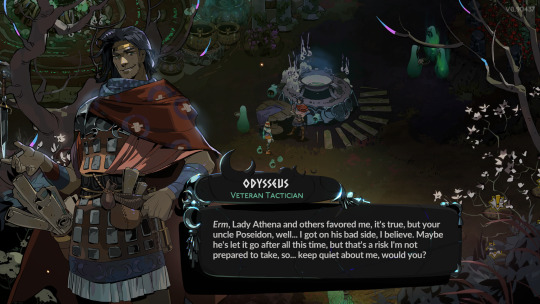
'Believe you got on his bad side' YOU ABSOLUTE NERD.
More when it's more finished I guess.
26 notes
·
View notes
Note
What is the "Lenore" folk song?
Take what I say with a grain of salt because I've only read a few of the ballads and one paper about them (which I would love to link, if only it was in English), but, in general it seems to have been a folktale/folksong widespread in the area of Germany and Poland that the Romantics in both countries latched on to and made their own versions of.
Tw: slight horror and implied demonic activity in the summary.
To recount the story (I'm roughly basing it on the polish ballad by Adam Mickiewicz which I know best), it begins with a girl (in other versions named Lenore), who receives news her lover is dead in some war or other. Her family wants her to get over him; the girl fights this. First she mopes, then she blasphemes, then she meets up with a witch of sorts, who promises to being her lover back.
Cue a rider with horse arriving at the gates in the dead of the night. The girl runs away with him. They ride a long whiles (at this point several comments tend to be made on how "the dead ride fast", or asking the girl if she's not afraid), the rider three times asking Lenore to throw away her prayerbook, cross/crucifix and rosary (I think these three, in the polish version at least, but anyway, religious objects) because they impede him in some way. In a striking display of lacking in genre-awareness (or even awareness of basic spiritual realities, I'd say), the girl sees nothing alarming in this, and follows through with his demands. Pursuant to which, they arrive at their destination, which to her surprise turns out to be a graveyard. Fire flashes from inside the rider and he takes the girl into the grave.
#I've always found it a little striking coming from the Romantics#known for their very reasonable attitudes towards romantic love and the deification thereof /s#but this is more or less how it goes#I'm not sure if the Mickiewicz ballad ever got an English translation but it is claimed Bürgers Lenore was the German poem#most translated into English so I think it should be easy to find on the internet#//#asks#original post#folklore#folk songs#romanticism#adam mickiewicz#Poland#polish culture#literary
14 notes
·
View notes
Photo

Devil with smilling belly, and two ladies.
Aleksandra Czudżak
#devil#folk#folklore#slavic#slavic folk#polish folk#diabeł#ilustracja#artwork#ink work#pagan#magic art#magical creature#witches#witchcraft#contemporary illustration#artist on tumblr#aleksandra czudżak#folk magic
1K notes
·
View notes
Text
Generally the style of dress was described rather than the actual physical manifestation of the devil, so one may assume that these devils were not monsters, or abnormally ugly. If they had had any particularly noticeable features, then perhaps they would have been mentioned. However, in one case, the devil was described as having horse’s hooves.
The only physical description was usually of the devil’s penis and it was an often repeated act that during sex, the devil’s member was cold; however, Agnieszka Jakóbka, during a second session of torture, confessed that ‘she enjoyed sex with the devil, and his nature was warm’.
- Jewish, Noble, German, or Peasant? The Devil in Early Modern Poland by Wanda Wyporska. [Demons, Spirits, Witches Vol. 2 :Christian Demonology And Popular Mythology - Gábor Klaniczay, Éva Pócs (Eds.)]
90 notes
·
View notes
Text
The Yaga journal: Witches and demons of Eastern Europe
The next article I’ll translate from the issue (I won’t translate all of them since some are not very relevant for this blog) is “Baba Yaga, witches, and the ambiguous demons of oriental Europe” by Stamatis Zochios.
The article opens by praising the 1863′s “Reasoned dictionary of the living russian language”. by scholar, lexicograph and folklorist Vladimir Dahl, which is one of the first “systematic essays” that collects the linguistic treasures of Russia. By collecting more than thirty thousand proverbs and sayings, insisting on the popular and oral language, the Dictionary notably talked about various terms of Russian folklore; domovoi, rusalka, leshii... And when it reaches Baba Yaga, the Dictionary calls her : сказочное страшилищ (skazochnoe strashilishh) , that is to say “monster of fairytales”.But the article wonders about this denomination... Indeed, for many people (such as Bogatyrev) Baba Yaga, like other characters of Russian fairytales (Kochtcheï or Zmey Gorynych) do not exist in popular demonology, and is thus exclusively a character of fairy tales, in which she fulfills very specific functions (aggressor, donator if we take back Propp’s system). But the author of this article wonder if Baba Yaga can’t actually be found in “other folkloric genres” - maybe she is present in legends, in popular beliefs, in superstitions and incantations.
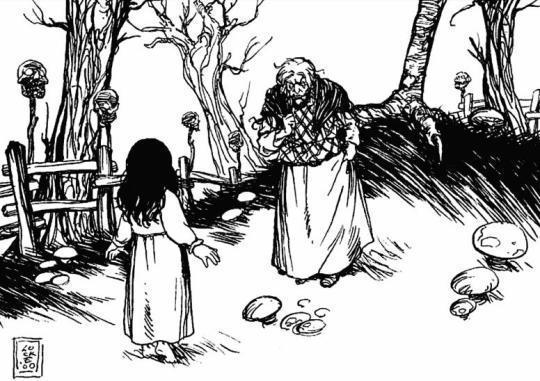
Baba Yaga, as depicted in the roleplaying game “Vampire: The Masquerade”
For example, in a 19th century book by Piotr Efimenko called “Material for ethnography of the Russian population of the Arkhangelsk province”, there is an incantation recorded about a man who wante to seduce/make a woman fall in love with him. During this incantation the man invokes the “demons that served Herod”, Sava, Koldun and Asaul and then - the incantation continues by talking about “three times nine girls” under an oak tree”, to which Baba Yaga brings light. The ritual is about burning wood with the light brought by Baba Yaga, so that the girl may “burn with love” in return. Efimenko also mentions another “old spell for love” that goes like this: “In the middle of the field there are 77 pans of red copper, and on each of them there are 77 Egi-Babas. Each 77 Egi-Babas have 77 daughters with each 77 staffs and 77 brooms. Me, servant of God (insert the man’s name here) beg the daughters of the Egi-Babas. I salute you, daughters of Egi-Babas, and make the servant of God (insert name of the girl here) fall inlove, and bring her to the servant of God (insert name of the man here).” The fact Baba Yaga appears in magical incantations proves that she doesn’t exist merely in fairytales, but was also part of the folk-religion alongside the leshii, rusalka, kikimora and domovoi. However two details have to be insisted upon.
One: the variation of the name Baba Yaga, as the plural “Egi-Babas”. The name Baba Yaga appears in numerous different languages. In Russian and Ukrainian we find Баба-Язя, Язя, Язі-баба, Гадра ; in Polish jędza, babojędza ; in Czech jezinka, Ježibaba meaning “witch, woman of the forest”, in Serbian баба jега ; in Slovanian jaga baba, ježi baba ... Baba is not a problem in itself. Baba, comes from the old Slavic баба and is a diminutive of бабушка (babyshka), “grand-mother” - which means all at the same time a “peasant woman”, “a midwife”, a (school mistress? the article is a bit unclear here), a “stone statue of a pagan deity”, and in general a woman, young or old. Of course, while the alternate meanings cannot be ignored, the main meaning for Baba Yaga’s name is “old woman”. Then comes “Yaga” and its variations, “Egi”, “Jedzi”, “Jedza”, which is more problematic. In Fasmer’s etymology dictionary, he thinks it comes from the proto-Slagic (j)ega, meaning “wrath” or “horror”. Most dictionaries take back this etymology, and consider it a mix of the term baba, старуха (staruha), “old woman”, and of яга, злая (zlaia), “evil, pain, torment, problem”. So it would mean злая женщина (zlaja zhenshhina), “the woman of evil”, “the tormenting woman”. However this interpretation of Yaga as “pain” is deemed restrictive by the author of this article.
Aleksandr Afanassiev, in his “Poetic concepts of the Slavs on nature”, proposed a different etymology coming from the anskrit “ahi”, meaning “snake”. Thus, Baba Yaga would be originally a snake-woman similar to the lamia and drangua of the Neo-hellenistic fairytales and Albanian beliefs. Slavic folklore seems to push towards this direction since sometimes Baba Yaga is the mother of three demon-like daughters (who sometimes can be princesses, with one marrying the hero), and of a son-snake that will be killed by the hero. Slovakian fairytales tale back the link with snakes, as they call the sons of Jezi-Baba “demon snakes”. On top of that, an incantation from the 18th century to banish snakes talks about Yaga Zmeia Bura (Yaga the brown snake): “I will send Yaga the brown snake after you. Yaga the brown snake will cover your wound with wool.” According to Polivka, “jaza” is a countryside term to talk about a mythical snake that humans never see, and that turns every seven years into a winged seven-headed serpent. With all that being said, it becomes clear (at least to the author of this article) that one of the versions of Yaga is the drakaina, the female dragon with human characteristics. These entities are usually depicted with the head and torso of women, but the lower body of a snake. They are a big feature of the mythologies of the Eurasian lands - in France the most famous example is Mélusine, the half-snake half-woman queen, whose story was recorded between the end of the 14th century and the beginning of the 15th by Jean d’Arras (in his prose novel La Noble Histoire de Lusignan) and by Couldrette (in the poetic work Roman de Mélusine). For some scholars, these hybrid womans are derived from the Mother Goddess figure, and by their physical duality manifest their double nature of benevolence-malevolence, aggressor-donator.
If we come back to the incantation of Efimenko, we notice that the 77 daughters of Baba Yaga each have a “metly”, a “broom”. This object isn’t just the broom Baba Yaga uses alongside her mortar and pestle to travel around - it is also the main attribute of the witches, and the witch with her broom is a motif prevalent in numerous textes of Western Europe between the 15th and 16th centuries. Already in medieval literature examples of this topic could be found: in the French works “Perceforest” and “Champion des dames”, the old witches are described flyng on staffs or brooms, turning into birds, to either eat little children or go to witches’ sabbaths. Baba Yaga travels similarly: Afanassiev noted that she goes to gathering of witches while riding a mortar, with a pestle in one hand and a broom in the other. Federowsky noted that Baba Yaga was supposed to be either the “aunt” or the “mistress” of all witches. Baba Yaga herself in often called an old witch, numerous dictionaries explaining her name as meaning старуха-колдунья (staruha-koldun’ja), which literaly means old witch. Even more precisely, she is an old witch who kidnaps children in order to devour their flesh and drink their blood. We find back in other countries of Europe this myth of the “bogeywoman cannibal-witch”, especially dangerous towards newborns and mothers, as the “strix” or “strige”. According to Polivka, in his 1922 article about the supernatural in Slovakian fairytales, the ježibaba is the same being as the striga/strige. And he also ties these two beings to the bosorka, a creature found in Slovakia, in eastern Moravia, and in Wallachia, and which means originally a witch or a sorceress, but that in folklore took a role similar to the striga or ježibaba.
Vinogradova, in a study of the figure of the bosorka, described this Carpathian-Ukrainian witch as a being that attacked people in different ways. For example she stole the milk from the cows - a recurring theme of witches tales in Western Europe (mentionned by Luther in his texts as to one of the reasons witches had to be put to death), but that also corresponds to a tale of the Baba Yaga where she is depicted as sucking the milk out of the breast of a young woman (an AT 519 tale, “The Strong Woman as Bride”). In conclusion, the striga-bosorka is clearly related to the Slovakian version of Baba Yaga, the Ježibaba. The Ježibaba, a figure of Western Slavic folklore, also appears as numerous local variations. She is Jenzibaba, Jendzibaba, Endzibaba, Jazibaba, and in Poland she is either “jedza-baba” (the very wicked woman) or “jedzona, jedza-baba, jagababa” (witch). However this Slovakian witch isn’t always evil: in three fairytales, Ježibaba is a helper bringing gifts, appearing as a trio of sisters (with a clear nod to the three fatae, the three moirae or the three fairies of traditional fairytales) who help the hero escape an ogre who hunts him. They help him by gifting him with food, and then lending him their magical dogs. And in other farytale, the three sisters help a lazy girl spin threads.
In this last case, Ježibaba is tied to the action of spinning. It isn’t a surprise as Baba Yaga herself is often depicted spinning wool or owning a loom ; and several times she asks the young girls who arrive at her home to spin for her (AT 480, The Spinning-Woman by the Spring) - AND in some variations, her isba doesn’t stand on chicken legs, but rather on a spindle. This relationship between the female supernatural figure (fairy or witch) and the action of spinning is very typical of European folkore. In several Eastern Slavic traditions, the figure of Paraskeva-Piatnitsa (or Pyatnitsa-Prascovia, who is often related to Baba Yaga), is an important saint, personification of Friday and protectress of crops - and she punishes women who dare spin on the fifth day of the week. Sometimes it is a strong punishment: she will deform the fingers of the woman who dares spin the friday, which relates her to the naroua (or naroue, narova, narove) a nocturnal fairy of Isère and Savoie in France, who manifests during the Twelve Days of Christmas and enters home to punish those that work at midnight or during holidays - especially spinners and lacemakers. In a Savoie folktales she is said to beat up lacemakers until almost killing them, hits them on the fingers with her wand, beats them up with a beef’s leg or a beef’s nerves, and attacks children with both a cow’s leg in one hand and a beef’s leg in another. These bans are also found in the Greek version of Piatnitsa: Agia Paraskevi, Saint Paraskevi, who punishes the spinners that work on Thursday’s nights, during Friday, or during the feast-day of the Saint (26 of July). But her punishment is to force them to eat the flesh of a corpse. Finally, we find the link between spinning and the demonic woman/witch/fairy through the Romanian cousin of Baba Yaga - Baba Cloanta, who says that she is ugly because she spinned too much during her life. And it all ties back to the “Perceforest” tale mentionned above - in the text, the witches, described as old matrons disheveled and bearded, not only fly around on staffs and little wooden chairs, but also by riding on spindles and reels/spools.
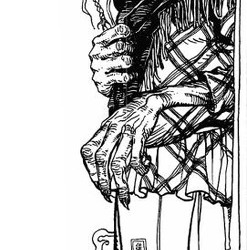
Another typical example of “demonic woman” often compared and related to Baba Yaga is the character known as “Perchta” in her Alpine-Germanic form, Baba Pehtra in Slovenia, or Pechtrababajaga according to a Russian neologism. The name Perchta, Berchta, Percht, Bercht comes from the old high German “beraht”, of the Old German “behrt” and of the root “berhto-”, which is tied to the French “brillant” and the English “brilliant”. So Berchta, or Perchta, would mean “the brilliant one”, “the bringer of light”. Why such a positive name for a malevolent character?
In 1468, the Thesaurus pauperum, written by John XXI, compares two fairies with a cult in medieval France, “Satia” and “dame Abonde”, with another mythological woman: Perchta. The Thesaurus pauperum describes “another type of superstition and idolatry” which consists in leaving at night recipients with food and drinks, destined to ladies that are supposed to visit the house - dame Abonde or Satia, that is also known as “dame Percht” or “Perchtum”, who comes with her whole “troop”. In exchange of finding these open recipients, the ladies will thenfill them regularly, bringing with them riches and abundance. “Many believed that it is during the holy nights, between the birth of Jesus and the night of the Epiphany, that these ladies, led by Perchta, visit homes”, and thus during these nights, people leave on the table bread, chesse, milk, meat, eggs, wine and water, alongside spoons, plates, cups, knives, so that when lady Perchta and her group visit the house, they find everything prepared for them, and bless the house in return with prosperity. So the text cannot be more explict: peasants prepared meals at night for the visit of lady Perchta, it is the custom of the “mensas ornare”, to prepare the table in honor of a lady visiting houses at night. If she finds offerings - cuttlery, drinks, food, especially sugary food - she rewards the house with riches. Else, she punishes the inhabitants of the home.
But Perchta doesn’t just punish for this missing meal. Several stories also describe Perchta looking everywhere in the house she visits, checking every corner to spot any “irregularity”. The most serious of those sins is tied to spinning: the woman of the house is forced to stop her work before midnight, or to not work on a holiday - especially an important holiday of the Twelve Days, such as Christmas or the Epiphany. If the woman is spotted working ; or if Perchta doesn’t found the house cleaned up and tidied up ; or if the flax is not spinned, the goddess (Perchta) will punish the woman. This is why she was called “Spinnstubenfrau”, “the woman of the spinning room”. It is also a nickname of a German spirit known as Berchta - as Spinnstubenfrau, she takes the shape of an old witch who appears in people’s houses during the winter months. She is the guardian spirit of barns and of the spinning-room, who always check work is properly and correctly done. And her punishment was quite brutal: she split open the belly of her victim, and replaces the entrails with garbage. Thomas Hill in his article “Perchta the Belly Slitther” sees in this punishment the remnants of old chamanic-initiation rite ; which would tie to it an analysis done by Andrey Toporkov concerning the “cooking of the child” by Baba Yaga in the storyes of the type AT 327 C or F. In these tales a boy (it might be Ivashka, Zhikharko, Filyushka...) arrives at Baba Yag’s isba, and the witch asks her daughter to cook the boy. The boy makes sure he can’t be pushed in the oven by taking a wrong body posture, and convinces the girl to show him how he should enter the oven. Baba Yaga shows him to do so, enters the oven, and the boy finds the door behind her, trapping Baba Yaga in the fire. According to Toporkov, we can find behind this story an old ritual according to which a baby was placed three times in an oven to give it strength. (The article reminds that Vladimir Propp did highlight the function of Baba Yaga as an “initiation rite” in fairytales - and how Propp considered that Baba Yaga is a caricature of the leader of the rite of passage in primitive societies). And finally, in a tale of Yakutia, the Ega-Baba is described as a chaman, invoked to resurrect a killed person. The author of the article concludes that the first link between Yaga and Perchta is that they are witches/goddesses that can be protectress, but have a demonic/punishment-aspect that can be balanced by a benevolent/initiation-aspect. But it doesn’t stop here.
The Twelve Days are celebrations in honor of Perchta, practiced in Germany, Austria and Switzerland. Still today, “Percht” is a term used to call masked person who haunt at night the villages of High-Styria or the land of Salzbourg: they visit houses while wearing masks, clothed in tatters and holding brooms. During these celebrations, young people either dress up as beautiful girls in traditional costumes (the schöne Perchten), either as ugly old woman (die schiache Perchten). These last ones are inspired by the numerous depictions of Perchta as an old woman, or sometimes a human-animal hybrid, with revolting trait - most prominent of them being the feet of a goose. This could explain in Serbia the existence of a Baba Jaga/Baba Jega with a chicken feet, or even the chicken feet carrying the isba of Baba Yaga. This deformation also recalls a figure of the French region of Franche-Comté, Tante Arie (Aunt Arie), another supernatural woman of the Twelve Days tied to spinning. The second most prominent trait of the “old Perchta” is an iron nose - already in the 14th century, Martin of Amberg wrote about “Percht mit der eisnen nasen”, “Percht with an iron nose”. Yaga also sometimes hag an iron nose, and this is why she was associated with other figures of Carpathian or Western Ukraine folklores - such as Zalizna baba or Zaliznonosa baba, the “old woman of iron”, who lives in a palace standing on duck legs ; there is also Vasorru Baba, the iron-nosed woman of Hungaria. Or Huld - another Spinsstubenfrau, often related to Perchta, but who has more sinister connotations. Huld has an enormous nose according to Luther, and Grimm notes that sometimes she appears as a witch with one very long tooth. This last characteristic if also recurring in Eastern Europe’s mythologies: in Serbia Gvozdenzuba (Iron Teeth) is said to burn the bad spinners ; and Baba Yaga is sometimes described with one or several long teeth, often in iron. But it is another aspect of the myths of Huld, also known as Holda or Frau Holle, that led the scholar Potebnja to relate her to Perchta and Baba Yaga.
According to German folk-belief, Huld (or often Perchta) shakes her pillowcases filled with feathers, which causes the snow or the frost ; and thunder rumbles when she moves her linen spool. It is also said that the Milky Way was spinned with her spinning wheel - and thus she controls the weather. In a very similar function, the Baba Jaudocha of Western Ukraine (also called Baba Dochia, Odochia, Eudochia, Dochita, Baba Odotia, a name coming from the Greek Eudokia) is often associated with Baba Yaga, and she also creates snow by moving either her twelve pillows, or her fur coat. According to Afanassiev, the Bielorussians believed that behind the thunderclouds, you could find Baba Yaga with her broom, her mortar, her magic carpet, her flying horses or her seven-league boots. For the Slovakians, Yaga could create bad or beautiful weather. In Russia, she is sometimes called ярою, бурою, дикою , “jaroju, buroju, dikoju”, a name connected to thunderstorms. Sometimes Yaga and her daughters appear as flying snakes - and the полет змея, the “polet smeja”, the “flight of the snake” was believed to cause storms, thunder and earthquakes. In a popular folk-song, Yaga is called the witch of winter: “Sun, you saw the old Yaga, Baba Yaga, the winter witch, this ferocious woman, she escaped spring, she fled away from the just, she brought cold in a bag, she shook cold on earth, she tripped and rolled down the hill.” Finally, for Potebnia, the duality and ambiguity of Baba Yaga, who steals away and yet gives, can be related to the duality of the cloud, who fertilizes the land in summer, and brings rain in winter. Baba Yaga is a solar goddess as much as a chthonian goddess - she conjointly protects births, and yet is a psychopomp causing death.
It seems, through these examples, that Baba Yaga is a goddess - or to be precise, a spirit of nature. Sometimes she is a leshachikha, the wife of the “leshii”, the spirit of the forest, and she herself is a spirit of the woods, living alone in an isolated isba deep in the thick forests. She is thus often paralleled with Muma Padurii, the Mother of the Forest of Romanian folklore, who lives in a hut above rooster’s legs, surrounded by a fence covered in skulls, and who steals children away (in tales of the type AT 327 A, Hansel and Gretel). This aspect of Baba Yaga as a spirit of the forest, and more generally as a “genius loci” (spirit of the place) also makes her similar to another very important figure of Slavic folklore: Полудница (Poludnica), the “woman of noon”. She is an old woman with long thick hair, wearing rags, and who lives in reeds and nettles ; or she can rather be a very beautiful maiden dressed in white, who punishes those that work at noon. She especially appears in rye fields, and protects the harvest. In other tales, she rather sucks away the life-force of the fields - which would relate her to some stories where Baba Yaga runs through rye fields (either with a scarf of her head, or with her hair flowing behind her). Poludnica can also look like Baya Yaga: Roger Caillois, in his article “Spectres de midi dans la démonologie slave” (Noon wraiths in the Slavic demonology), mentionned that Poludnica was a liminal deity of fields, to which one chanted полудница во ржи, покажи рубежи, куда хошь побѣжи !, “Poludnicaa in the rye - show the limits - and go where you want.” This liminal aspects reminds of an aspect of Baba Yaga as a genius loci, tied to a specific place that she defends. It is an aspect found as Baba Yaga, Baba Gorbata, Polydnitsa and Pozhinalka: Baba Yaga is either a benevolent spirit that protects the place and the harvest ; either she is a malevolent sprit that absorbs the life-force of the harvest and destroys it. This is why she must be chased away, and thus it explains a Slovanian song that people sing during the holiday of Jurij (the feast day of Saint George), the 23rd of April, an agrarian holiday for the resurrection of nature: Zelenga Jurja (Green George), we guide, butter and eggs we ask, the Baba Yaga we banish, the Spring we spread!”. This chant was tied with a ritual sacrifice: the mannequin of an old woman had to be burned. As such, Baba Yaga and her avatars, was a spirt that had to be hunted down or banned - which is a custom found all over Europe, but especially in Slavic Europe. At the end of the harvest, several magical formulas were used to push away or cut into pieces the “old woman” ; and we can think back of Frazer’s work on the figure of the “Hag” (which in the English languages means as much an old woman as a malevolent spirit), who is herself a dual figure. In a village of Styria, the Mother of wheat, is said to be dressed in white and to be born from the last wheat bundle. She can be seen at midnight in wheat fields, that she crosses to fertilize ; but if she is angry against a farmer, she will dry up all of his wheat. But then the old woman must be sacrificed - just like in the feast of Jurij.
The author concludes that the “folkloric” aspect of Baba Yaga stays relatively unknown in the Western world and the non-russophone lands. The most detailed and complete work the author could find about it is Andreas Johns’ book “Baba Yaga: The Ambiguous Mother and Witch of the Russian Folktale”. The author of the article tried to prove that, as Johns said, the Baba Yaga is fundamentaly ambiguous - at the same time a kidnaping witch, a psychopomp, a cannibal, a protectress of birth, a guardian of places, a spirit of nature and harvests... And that she is part of an entire web and system of demon-feminine figures that create a mythology ensemble with common characteristic - very present in Eastern Europe, but still existing on the continent as a whole.
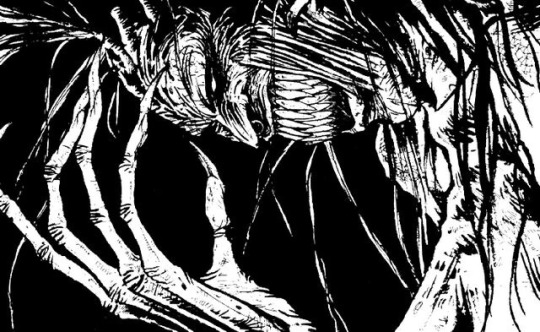
#the yaga journal#baba yaga#slavic folklore#eastern europe folklore#european folklore#perchta#fairies#fairy folklore#demonology#demons#witches
57 notes
·
View notes
Note
what are your thoughts on being a luciferian/satanist while also using catholic aesthetics and imagery? I don’t want to be disrespectful to the Christian faith, but I’m just so in love with the symbols and rituals of Catholicism. I’m also obsessed with mother Mary and Jesus tbh, though I’m more drawn to the human, Jesus of Nazareth.
I'm an ex-Catholic and Polish, so Catholicism is part of both my upbringing and culture. To me, including and recontextualizing some Catholic practices and imagery, or subverting them, is an act of reclamation and defiance in face of of oppression. Because the Catholic Church is an incredibly oppressive institution and whenever it gets enough political power, it uses it to force its ideas on people (for example here in Poland it both supports and influences the decisions of the right-wing ruling party). Catholicism is a major factor in Polish queerphobia, it is also a religion that actively proselytizes and has itself adopted lots of elements from other religions in the process of christianization.
Mother Mary veneration in particular was shaped by syncretizations with various goddesses. She is not considered a goddess herself, though my Catholic mom says she "functionally" is lol. At the same time, she was a feminine figure people could connect with in Christian cultures throughout the ages (and though sweet, she actually was not just a delicate flower at all). In my experience, she is a really kind and welcoming entity, accepts me as I am and has never stopped acting loving and motherly towards me. Out of respect I do things for her separately from my demonic practice, and when I properly print my Rainbow Madonna picture, I will just put it on my ancestor altar which not only doesn't involve demons, but makes sense with my family and cultural heritage. She also often appears in Polish folk magic though, which makes me very happy as a witch, especially since my practice with her is mostly rooted in local Folk Catholicism (I have already worked with her as a witch, just had a break).
I have also recently approached Hildegard of Bingen, in the context of more religion-neutral ancestor veneration rather than Catholicism, we will see how that one goes.
I don't worship Christian God (Jesus included) for various reasons, so I won't be saying much here, though I know there are people taking more of a dual faith approach here.
@saint-stanthony you are a Luciferian who also practices folk Catholicism, would you share some thoughts if that's alright with you?
30 notes
·
View notes